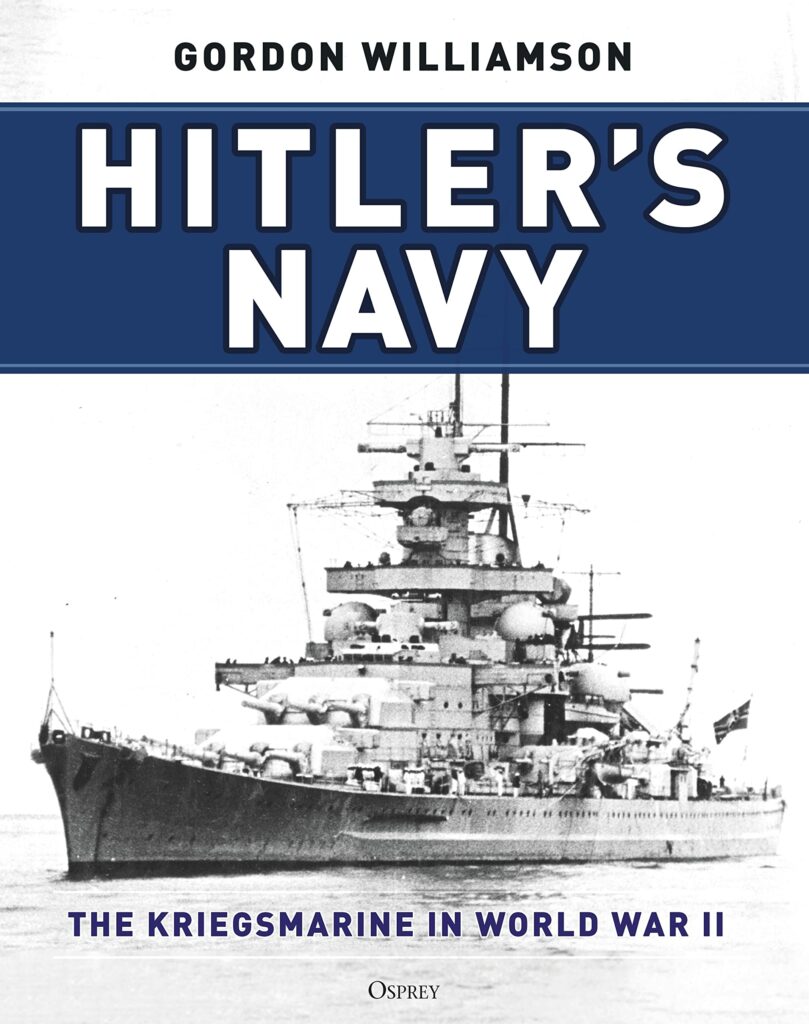Reviewed by CAPT Chuck Good, USN (Ret)
Broad in scope and rich in detail, Hitler’s Navy is a comprehensive overview of the ships, organization, and sailors of the Kriegsmarine. As befits Osprey’s core competency in producing monographs of famous ships and classes, the work is lavishly illustrated and full of technical detail. For those seeking focused accounts of famous campaigns or battles, such as the River Plate, Denmark Strait or the Norwegian Campaign, this is not the work. These engagements have been the focus of many previous works, and the author chooses to give them a minimalist summary in his first chapter. But Hitler’s Navy makes up for the lack of fighting narrative in its ambitious breadth.
Not only does Williamson cover “the usual suspects” – Bismarck, Tirpitz, the “pocket battleships” and the U-Boats – he gives a full accounting of the lesser-known but often harder-fought light vessels. Significant coverage is given to the light and coastal forces – S-Boats, minesweepers/layers, Torpedoboote, Sperrbrechers, and human torpedoes – as well as to the Auxiliary Cruisers (“Raiders”) and their global network of replenishment ships. His coverage of the U-Boat arm – the Navy-within-the-Navy which came to dominate the Kriegsmarine as the larger ships were checked by Allied seapower – is a brisk but comprehensive look at the progression from small coastal types to the seagoing boats of the Battle of the Atlantic, and finally to the highly advanced “Elektroboote” of the war’s waning days. Regardless of size or category, each ship type and class is shown in evolving fashion to reflect the changes in warfare from 1939 to 1945 as radar and AA capability become increasingly vital.
As well, Hitler’s Navy takes time to paint a picture of service in the Kriegsmarine for the average officer and rating. Training, schools, technical specialty groupings, rank, pay, and uniform are touched on. It is in this section, however, that Williamson treads on dangerous ground. His frank admiration for the Kriegsmarine shows through clearly. While it is both true and important to understand that the Kriegsmarine was the most traditional and least “Nazi-fied” of the various WWII German branches of service, and despite many fine examples of chivalrous conduct in the war’s early years, one should perhaps not so openly admire the foe, particularly when the title of the book is Hitler’s Navy.
Unfortunately, Williamson’s sweeping scope is also compromised by slipshod editing. One gets the feeling that there were many more pages of material provided than fit within 250 pages, leaving it to editors to determine best fit. Accordingly, parts of the narrative are choppy; for example, in examining the famous Scharnhorst, we are treated to details of her 1939 post-commissioning improvements before skipping directly to the finding of her wreck in 2000 with nary a mention of further changes to her configuration between the war’s beginning and her loss at the North Cape. Further, there are several incorrect or reversed illustrations and captions throughout the book which add a bit of momentary confusion until the reader sorts them out.
More surprisingly, there are a few technical inconsistencies, which are not in keeping with Osprey’s typical attention to detail. In one case, the otherwise superb overview of the Kriegsmarine’s five modern light cruisers shows tabular data that the secondary batteries of all five were twelve 10.5 cm types, but the narrative mostly refers to them as six 8.8 cm, which matches other references. Williamson himself knows the correct caliber and number of these weapons, as well as planned upgrades, as he is the author of another Osprey book specifically focused on the Kriegsmarine’s light cruisers. These factual differences more serve to highlight a compromised editing process than any lack of knowledge on the author’s part.
These niggling issues prevent a very good reference from becoming a great work, but the book is nevertheless both solid and worthwhile for any avid naval historian who wants “one stop shopping” for a view of the Kriegsmarine from its origins in the interwar years to the wreckage and rare few museum ships which mark its passage. A revision which corrects errors and fleshes out the narrative just a bit more would be most welcome.
Hitler’s Navy: The Kriegsmarine in World War II. By Gordon Williamson (Oxford: Osprey Publishing, 2022)



Barrett Tillman